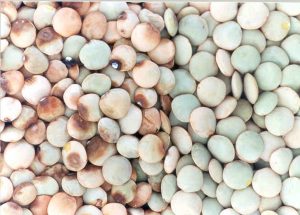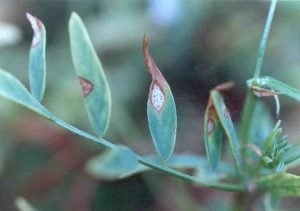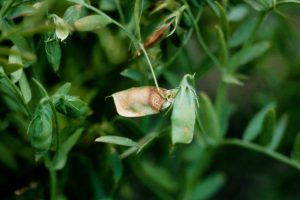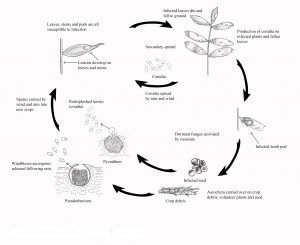The fungal pathogen Ascochyta lentis causes ascochyta blight of lentil and is an important disease in most lentil producing countries. The disease can reduce crop yields under severe conditions, but mainly affects seed quality and hence marketability. Seed discolouration, as a result of Ascochyta infection, is often heavily discounted in price and may be rejected by some buyers. Ascochyta blight is favoured by cool, wet conditions and is likely to be a problem in years with wet winter conditions and in high rainfall areas. Heavy rainfall during podding can often result in pod infection.
What to Look For
All above ground parts of lentil plants can be affected by ascochyta blight. Symptoms may appear on plants from the seedling to mature stages. The disease appears as spot-like lesions which are initially light grey but become tan with a dark brown margin.
The centres of lesions become speckled with pycnidia (tiny, dark fruiting bodies). The presence of pycnidia is the best way of identifying ascochyta blight lesions from those caused by other diseases such as botrytis grey mould or stemphylium blight. Heavy infections of ascochyta blight will cause premature leaflet drop and stem dieback at the growing tips giving plants a blighted appearance.
Pod infection can lead to seed infection and discolouration of the grain. Infected seed generally has brown patches on the seed surface, but may show no symptoms at all. Compared to healthy seed, heavily infected seed is purplish-brown, shrivelled and reduced in size.

Lentil seed infected with ascochyta blight. Note dark brown margin and fruiting bodies present in (left), healthy seed (right) the centre of the lesions.
Disease Cycle
The fungus may either be seed borne or survive on infected stubble from previous diseased crops. While the disease can become established as a result of sowing infected seed, the pathogen may also infect new crops when spores from infected stubble are carried by the wind from old lentil paddocks. Infection can occur at any stage of plant growth; however, moisture is essential. Cool, wet weather promotes sporulation, spore dispersal and infection. Secondary spread within crops occurs when spores produced on diseased plants are carried by wind and rain-splash onto neighbouring plants. Heavy rainfall late in the season provides ideal conditions for pod infection and subsequent seed discolouration.
Management
Clean Seed
Using old or damaged seed can reduce seedling vigour and increase susceptibility to infection. Only sow seed with less than 5 per cent Ascochyta infection and preferably use seed with nil infection.
Resistant Varieties
Use varieties with the greatest resistance. There are a range of varieties available that are MR or R to Ascochyta infection with attributes to suit most lentil growing areas in Victoria.
Paddock Selection
Infected crop residues can harbour Ascochyta lentis. Therefore, avoid planting this season’s crop near old lentil stubble. A program of stubble reduction may also be undertaken by grazing or burying to reduce the carry-over of infected stubble into the following season. Allow a break of at least 3 years between lentil crops.
Seed Treatment
Use a registered seed treatment for the control of seed-borne diseases in lentil. Seed treatments can have a deleterious effect on rhizobia. Therefore, seed should be treated with fungicide and then inoculated with rhizobia in two separate operations. Rhizobia should be applied to seed immediately before sowing, especially on acid soils.
Time of Sowing
Early sowing encourages early infection and increased levels of the disease. Follow the recommended sowing dates for your district.
Foliar Fungicides
In areas of high risk, it may be necessary to apply foliar fungicides to protect crops especially if a susceptible variety is grown. Use a registered product; remember that most fungicides are protectants and are most effective if applied before disease development.
Fungicides should be applied according to label directions for use, ensuring the key points of spray timing and frequency are observed as well as grazing and harvest withholding periods.






